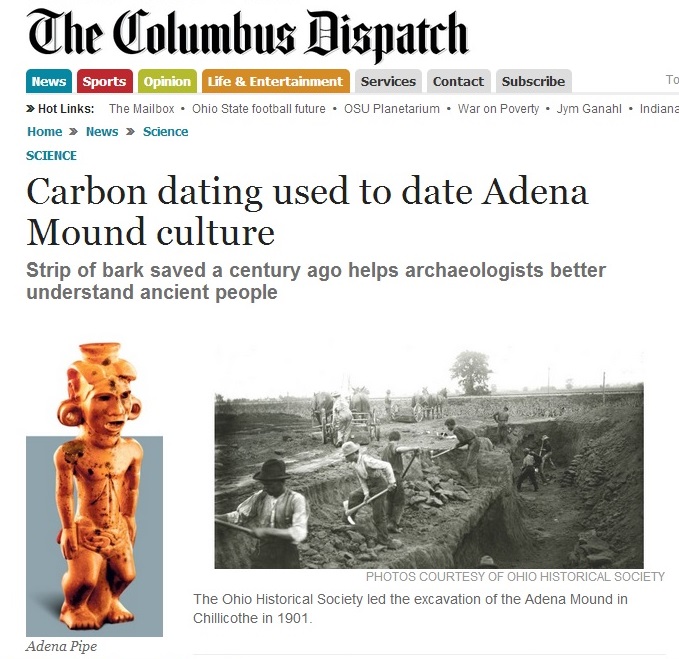 Check out today’s Columbus Dispatch for an article presenting new radiocarbon dates for the Adena Mound. It might seem surprising, but even though the Adena Mound is one of Ohio’s most important ancient sites and the amazing Adena Effigy Pipe — our State Artifact — was found there, we haven’t known exactly just how old it is. We’ve pretty much known the mound belonged to the Adena culture in fact, as the “type site”* for the Adena culture it basically defined it. But that only placed the Adena Mound within the broad Early Woodland period, which extended from about 1000 B.C. to A.D. 100. To determine a more precise age for the mound, modern archaeologists have available a variety of scientific dating techniques. The method used most often is radiocarbon dating, which requires that you have some organic material, such as wood or bone to analyze.
Check out today’s Columbus Dispatch for an article presenting new radiocarbon dates for the Adena Mound. It might seem surprising, but even though the Adena Mound is one of Ohio’s most important ancient sites and the amazing Adena Effigy Pipe — our State Artifact — was found there, we haven’t known exactly just how old it is. We’ve pretty much known the mound belonged to the Adena culture in fact, as the “type site”* for the Adena culture it basically defined it. But that only placed the Adena Mound within the broad Early Woodland period, which extended from about 1000 B.C. to A.D. 100. To determine a more precise age for the mound, modern archaeologists have available a variety of scientific dating techniques. The method used most often is radiocarbon dating, which requires that you have some organic material, such as wood or bone to analyze.
In 1901, when William C. Mills was excavating the Adena Mound on behalf of the Ohio Historical Society, radiocarbon dating had not yet been invented. Nevertheless, Mills saved several pieces of tree bark that had been used to line the central grave at the base of the mound. So more than a century later, we were able to use a couple of pieces of this bark, along with a small fragment of textile made from organic fibers, to obtain three radiocarbon dates. The bark produced dates of around A.D. 40, whereas the textile gave a date of 140 B.C. One possible explanation for why the textile appears to be so much older than the bark may be that the Adena people used an heirloom garment or shroud in the burial. Now we can place the Adena Mound and, by extension, the Adena Man Effigy Pipe, into their rightful place in the timeline of Ohio’s history. We report the complete results of our analyses in an upcoming issue of the Midcontinental Journal of Archaeology: Here is the full reference along with the abstract of the paper: Bradley T. Lepper, Karen L. Leone, Kathryn A. Jakes, Linda L. Pansing, and William H. Pickard 2014 Radiocarbon dates on textile and bark samples from the Central Grave of the Adena Mound (33RO1), Chillicothe, Ohio. Midcontinental Journal of Archaeology>; Volume 39, Number 1, pages 1-21. Abstract The Adena Mound (33RO1) is the type site of the Adena culture, yet there have been no radiocarbon dates to place it reliably within a temporal framework. Fortunately, the artifact collection, curated by the Ohio Historical Society, includes objects that are highly suitable for radiocarbon dating, including fragments of textiles and tree bark associated with the central burial. We selected a textile fragment and two bark fragments for radiocarbon dating. The textile exhibits alternate pair twine with very fine yarns likely composed of cellulose bast fibers. The bark is from a black locust (Robinia pseudoacacia) tree. The results of the radiocarbon dating indicate that the Adena Mound was constructed between the end of the second century B.C. and the beginning of the first century A.D. placing it near the midpoint in the sequence of radiocarbon-dated Adena culture sites. This study demonstrates the value of museum collections for gleaning new data from curated materials. For more information about the Adena Mound, you can check out my 2010 article “The Adena Pipe: icon of ancient Ohio” in Timeline magazine, Volume 27, Number 1, pages 2-15. Brad Lepper __________ * A “type site” usually is the first of its kind to be scientifically studied and it becomes the yardstick by which other sites are measured to see if they belong to the same culture or not.